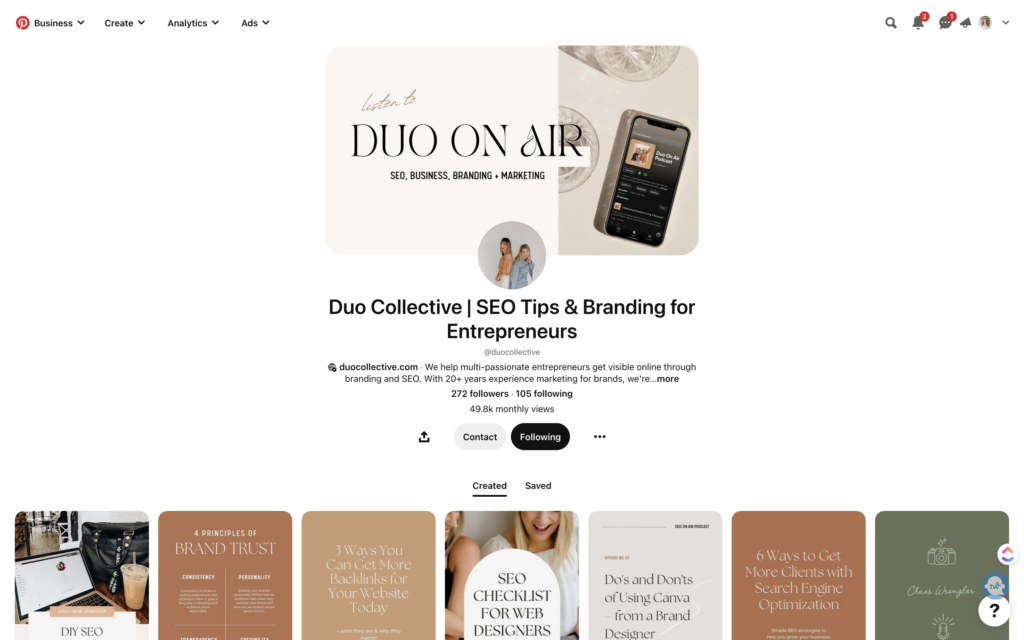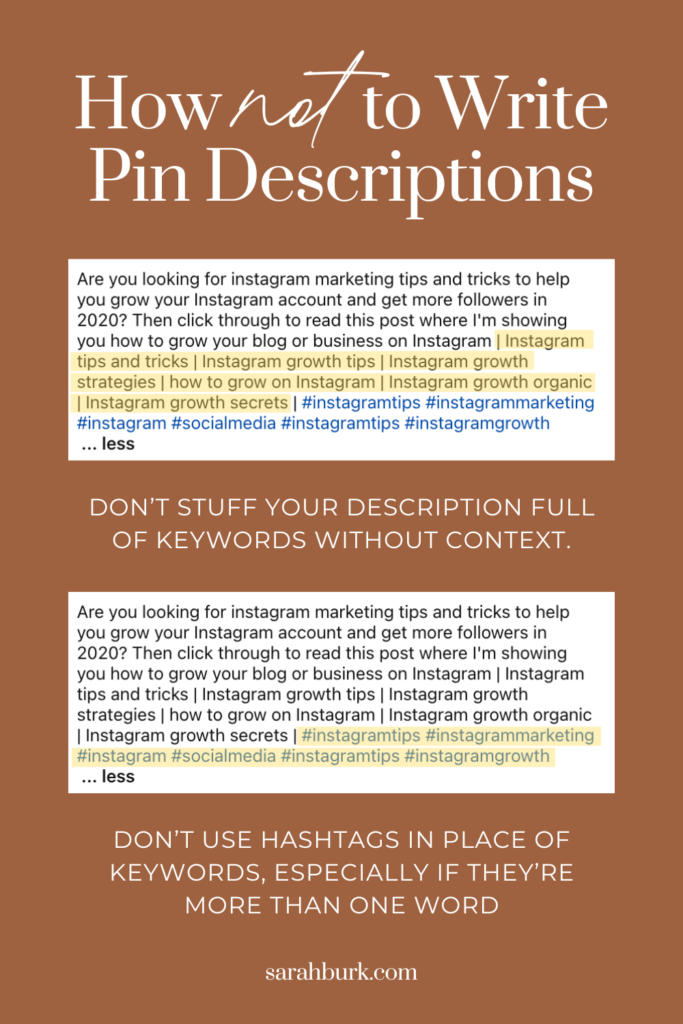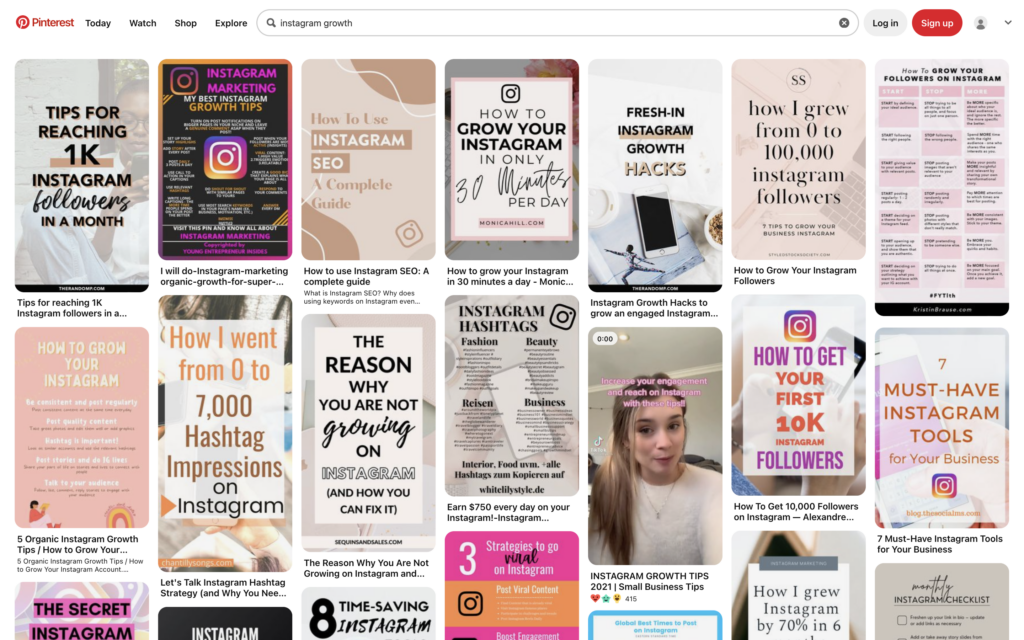Do you know what’s scarier than ghosts and goblins? Outdated Pinterest marketing tactics.
There are a lot of Pinterest myths and misconceptions out there, from the well-meaning and ill-informed to the downright dangerously incorrect.
As a Pinterest service provider who’s always learning more about Pinterest and staying on top of the best practices, it always hurts a little to see business owners falling for these ineffective strategies and “hacks”.
That’s why I’m breaking down all of the most common Pinterest myths and outdated Pinterest practices telling you what will actually work.
Just call me Mythbusters.
6 Common Pinterest Myths to Avoid
1. You need to pin a ton of content every day if you want to grow
30 pins per day used to be the recommended pinning frequency several years ago. And some Pinterest marketers will tell you that pinning 30, 50, or 100 times per day is the surefire way to see success from Pinterest.
You absolutely do not need to be pinning that frequently.
There might be some truth to the idea that you could grow more quickly by posting more content every day, but to effectively create Pinterest content on that scale would take more content and team members than the average service-based business owner has to dedicate to just one part of their marketing strategy.
What to Do Instead:
Focus on creating fresh, high-quality content consistently, even if that’s just one pin per day. You can scale up if possible, but don’t hold yourself to an impossibly high standard. Unless you have hundreds and hundreds of blog posts and products to link to, I don’t even think this would be possible without triggering the Pinterest spam filter.
2. Repin other users’ content to avoid looking “spammy”
Have you ever heard about the 80/20 rule of Pinterest content? That refers to the idea that 20% of your pins should be your own content and 80% should be repins of other users’ content.
(Hint: that’s how it was so easy for Pinterest creators back in the day to reach 30+ pins per day.)
The truth is that repinning content won’t do anything for your Pinterest growth. This is probably one of the outdated Pinterest tactics I hear talked about the most, and it’s probably because the concept makes logical sense.
You think you don’t want to seem overly salesy or promotional, so you’re going to share other pins in addition to your own.
But the way the Pinterest algorithm displays pins, your followers aren’t going to see the other things you repin. Heck, they won’t even see every pin that you post yourself! The default view of a Pinterest user’s profile shows only pins they have created. Here’s what that looks like:

And it is more than okay to market yourself on the platform. In fact, it’s both expected and encouraged.
What to Do Instead:
Focus on your own content. You can save other Pinterest content if you want, but it shouldn’t be part of your overall Pinterest strategy.
3. Make sure to include hashtags and a keyword list in every pin description
Hey! This is called keyword stuffing! And it’s spammy behavior!
Before the search algorithm was more advanced, it was easy to throw a huge block of keywords into your pin description and that would be enough to get your pins ranking. Now, the algorithm is more sophisticated. Pinterest wants to make sure that the keywords you’re using in your pin descriptions actually accurately describe the content. To that end, they advise against spam-like behavior such as keyword stuffing.

When it comes to Pinterest hashtags, the truth to this Pinterest myth is a little more complex.
Similarly to keyword stuffing, there was a slight association with overuse of hashtags on Pinterest to spam accounts. Hashtag functionality has also varied quite a bit over the years. Currently, if you see hashtags in a pin description, they’ll appear as hyperlinks that take you to the search results for that word or phrase.
If you compare the search results for “Instagram growth” to the search results pulled up when you click on the #instagramgrowth hashtag (which runs a search for “instagramgrowth”), the results are wildly different. And one is clearly much more accurate…


Either way, Pinterest users don’t really use hashtags the same way they do on Instagram, so using hashtags in place of keywords is just wasting space in my opinion.
What to Do Instead:
Choose 3-5 Pinterest keywords to include in your pin description. Write them naturally throughout your sentences, and don’t worry about hashtags!
Here are two great examples of pin descriptions that have been written to incorporate keywords well:

Example A is a bit of a longer pin description, but it includes several related keywords surrounding the topic of Instagram bios and profiles. The description also references benefits their audience might desire, such as attracting followers and driving more business from Instagram.
Example B is an excellent example of a short but effective pin description. There are multiple keywords in this description, to the point where nearly the whole description is keywords:
- engaging content ideas
- content ideas for small business
- content ideas to use on Instagram
- content strategy
- create a content strategy
- plan your content
- plan your content for a month
- social media content ideas
4. Pinterest is only for product-based businesses (or photographers, or bloggers, or…)
In the early days of Pinterest, there was definitely a misconception that it was only for bloggers – especially food bloggers or DIYers.
Then, during a Q2 earnings call, CEO Bill Ready shared that shopping and e-commerce were a primary focus for the platform in the future. Even the hiring of Bill Ready, who worked with commerce and payments at Google, seemed to indicate a turn towards all things shopping.
Cue the panic.
Aaaaaand panic over.
You don’t have to sell products to succeed on Pinterest.
Yes, Pinterest is great for e-commerce businesses and users are well primed to purchase.
But the foundation of the platform is as a source of inspiration and information for users.
What to Do Instead:
Don’t panic to convert your service-based business to a product-based business model, and don’t think you have to leave Pinterest because “it won’t work for you.”
Keep focusing on the bread and butter of your Pinterest strategy – SEO-optimized pins linking to valuable content. If you do sell products (digital or otherwise), take advantage of some of the shopping features if you like!
5. Organic growth on Pinterest is impossible
“Engagement sucks, ads are the only way to grow.”
Have you ever heard that before? If yes, let me ask you another question — was it an ads expert or manager telling you this?
Organic marketing is alive and well, as long as you know how to do it.
Pinterest ads can be an effective part of your overall marketing strategy, but they aren’t necessary by any means. Furthermore, they aren’t a shortcut to organic success. As soon as you stop funding those campaigns, your metrics will dip again and you get into an ads spiral.
If you’ve got the budget for it, by all means go for it. But ya don’t have to.
What to Do Instead:
Wait at least 6 months to judge the efficacy or ROI of your Pinterest marketing efforts before concluding that ads are the only way to go. If you think you want to add paid Pinterest marketing to your strategy, go ahead and set up your Pinterest Tag so you can have lots of data collected to work with.
Heather Farris is a great resource for education and support on Pinterest Ads!
6. Just repost your TikToks and Reels as pins
See also: “You don’t need a website to market on Pinterest, you can just link back to your Instagram/TikTok!”
Imagine you see a video on Pinterest talking about 3 ways you can make more money from home. You’re pumped and ready to learn more, but then the link on the pin takes you to the exact same video you just watched, but on a different app.
How annoyed would you be???
If you’re going to be repurposing your short-form video content, make sure you’re offering additional value beyond the video itself.
Another outdated Pinterest marketing tactic (that’s just plain wrong) is using the same caption from Instagram for your pin description.
The way you write Instagram captions is very different from the way you should be writing pin descriptions. Instagram captions are for an audience that already knows you and will be interested in a cutesy little hook or storytelling moment. Your pin descriptions need to be keyword-rich and compel users to take action by clicking on the pin. We don’t have room for an analogy here.
What to Do Instead:
Take the few extra minutes to reformat your social media content into Pinterest-friendly format. I promise it’s worth it!
If you’ve been using any of these outdated Pinterest tactics or have fallen for some of these Pinterest myths, it’s okay! At the beginning of my Pinterest marketing journey, I definitely promoted some of these strategies.
So believe me when I say we can learn and change together!
Data-backed, strategic, sustainable marketing practices will always be the key to success on Pinterest.
If you’ve heard any other Pinterest rumors floating around, drop me a line on IG and let me know! I’ll update the post accordingly.
And if you’re looking for a Pinterest marketing pro in your back pocket to save you from any of these scary strategies, I’ve got plenty of ways to help.
>> Browse my favorite free and paid resources for online business owners.
